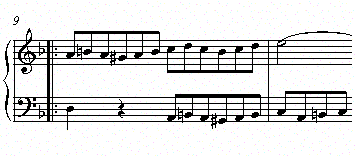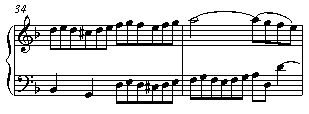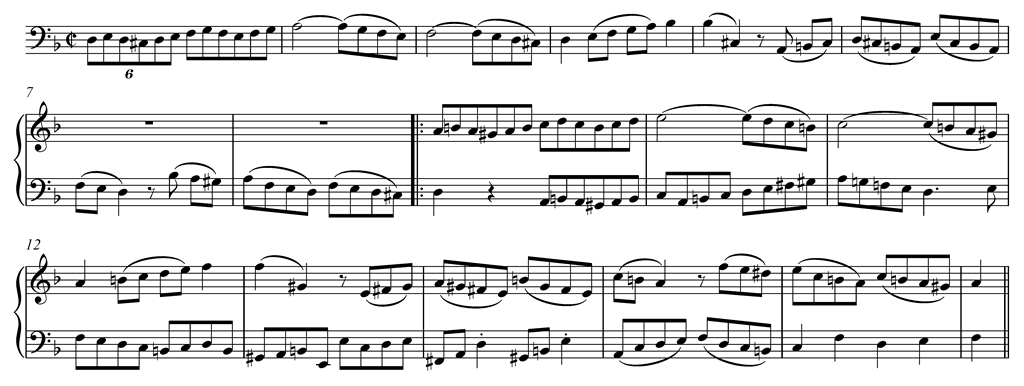Canon alla Duodecima in contrapunto alla Quinta
José Rodríguez Alvira
The Canon alla Duodecima in contrapunto alla Terza is an excellent example of the use of the inversion at the twelve technique. If you need help understanding the contrapuntal inversion technique read Invertible Counterpoint. Let's take a look at the formal structure of this canon before looking into the invertible counterpoint issue.
The canon begins with an 8 measures theme or subject. Notes in red are those from the original theme in which this canon and all fugues are based:
The second voice begins in measure 9 but the imitation is at the twelve or fifth:

Listen to the first 16 measures:
In measures 17 to 33 the upper voice continues the imitation of the lower voice. In measure 34 it presents the subject:

From measures 34 to 41 the lower voice will add a new counterpoint. From measure 42, measures 9 to 33 are repeated but with the voices inverted at the twelve. The lower voice transposes two octaves higher and the upper voice one twelve lower. Because of the type of inversion used, the lower voice will now imitate the upper voice at the octave and not at the twelve as in the first part:

The upper voice in measure 9 becomes lower voice in measure 42 but transposed one twelve lower (A becomes D). The lower voice of measure 9 is transposed two octaves higher in measure 42.
In measures 68 a 75 the lower voice presents the subject. The upper voice uses the counterpoint from measures 34 to 42, but transposed a twelve higher. A short coda (76 - 78) ends this canon.
A short summary of the structure:
| Measures | |
|---|---|
| 1 - 33 | The upper voice imitates the lower voice one twelve higher |
| 34 - 41 | The subject reappears in the upper voice while the lower voice presents a new counterpoint to the subject |
| 42 - 67 | The lower voice begins imitating the upper voice using the inversion at the twelve |
| 68 - 75 | The subject reappears in the lower voice. The counterpoint from measures 34 - 41 reappears in the upper voice using inversion at the twelve |
| 76 - 78 | Coda |
Listen to the complete canon. We have highlighted the imitations using numbers. For example, the subject is labeled as 1 and when imitated by the upper voice, the upper voice imitation will be labeled as 1. We also show the intervals between voices:
Invertible counterpoint in the canon at the twelve
We will now analyze how Bach works out the problems related to the use invertible counterpoint. In invertible counterpoint at the twelve the sixths intervals are problematic because after inversion they become sevenths. How does Bach handles this problem?
After an analysis of the intervals used by Bach, we find that he uses mostly thirds, some fifths and octaves and very few sixths. Clearly he tries to stay away from the problematic sixth interval as you can see in the previous example.
Inversion at the twelve table
| 2 | 3 | 4 | 5 | 6 | 7 | 8 | 9 | 10 | 11 |
| 11 | 10 | 9 | 8 | 7 | 6 | 5 | 4 | 3 | 2 |
Some examples using sixth and sevenths.
The way Bach works around the problems with the sixths and sevenths intervals is using the seventh interval as a suspension or as part of a dominant chord harmony. Once inverted the resulting sixth interval presents no problem.
Measures 11 and 44

The seventh interval in measure 11 is used as a suspension. No problem is caused when it inverts in a sixth in measure 44.
Measures 13 and 46

The seventh in measure 13 is the 9th of the E dominant chord. When inverted the note becomes the seventh of the C# diminished seventh chord.
Measures 16 and 49

Once again the seventh in measure 16 is used as a suspension.
These are good examples of how you can use sixths and sevenths in invertible counterpoint at the twelve.
Recordings:

